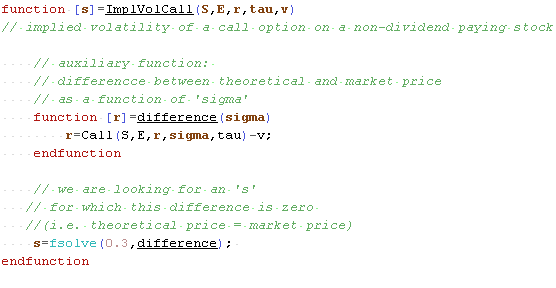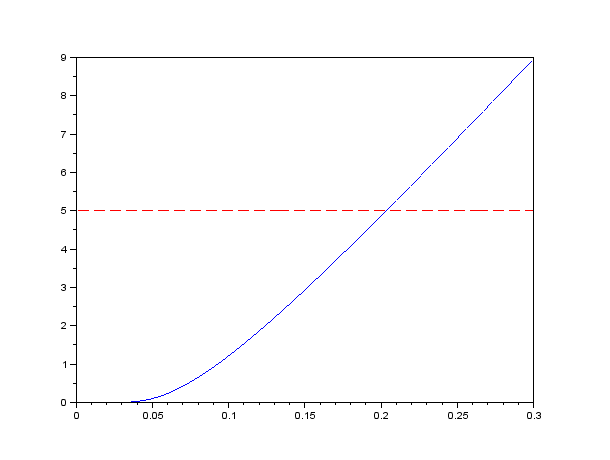Black-Scholes model: implied volatility
:: Implied volatility ::
- Implied volatility is the value of volatility
which, after substituting into the Black-Scholes formula, gives the market value of the option.
- Dependence of the call option price on the stock volatility:
- The call option price is an increasing function of the volatility.
- As the volatility approaches zero, the limit of the price is max(0,S-E*exp(-r
 )).
)).
- As the voltility approaches infinity, the option price approaches the stock value S
- Hence, if the market price of an option is from the interval (max(0,S-E*exp(-r
 )),S), then the implied volatility exists and it is unique.
)),S), then the implied volatility exists and it is unique.
- There are several ways of implementing computation of implied volatility; here is one of them:
What does it do:


- Scilab function ImplVolCall is a part of the file black_scholes.sci given with the previous topic.
:: Exercises ::
- Modify the graph above - use a wider rage of volatility on the horizontal axis, so that the limit at infinity can be observed.
- Choose the parameters values which show both possible beginnings of the curve (when stock price approaches zero).
- Try the computation of the implied volatility for a given option - this is important; we will need it when studying so called Leland model.
:: Practice problems ::
- Implied volatility for other options - derive its existence and uniqueness, write a script implementing its computation for the given data and use it to compute the implied volatility for selecte parameters:
- put option written on a stock that does not pay dividends
- call a put options on a stock that pays continuous dividends with continuous dividend rate q
Financial derivatives - exercises, 2014
Beáta Stehlíková, FMFI UK Bratislava
E-mail: stehlikova@pc2.iam.fmph.uniba.sk
Web: http://www.iam.fmph.uniba.sk/institute/stehlikova/
Beáta Stehlíková, FMFI UK Bratislava
E-mail: stehlikova@pc2.iam.fmph.uniba.sk
Web: http://www.iam.fmph.uniba.sk/institute/stehlikova/